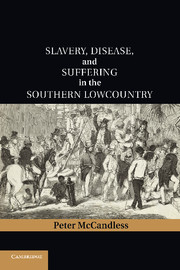Book contents
- Frontmatter
- Contents
- List of Figures
- List of Maps
- Preface
- Acknowledgments
- List of Abbreviations Used in Notes
- MAP 1 The Lowcountry, Charleston, and the Caribbean region
- MAP 2 The South Carolina lowcountry, showing Anglican parishes and slave proportion of population, c. 1760s
- MAP 3 Charleston Harbor, based on a British map, c. 1780
- MAP 4 The Revolutionary War in the South
- PART I TALK ABOUT SUFFERING
- PART II COMBATING PESTILENCE
- 8 “I Wish That I Had Studied Physick”
- 9 “I Know Nothing of this Disease”
- 10 Providence, Prudence, and Patience
- 11 Buying the Smallpox
- 12 Commerce, Contagion, and Cleanliness
- 13 A Migratory Species
- 14 Melancholy
- Bibliography
- Index
- References
12 - Commerce, Contagion, and Cleanliness
Published online by Cambridge University Press: 03 May 2011
- Frontmatter
- Contents
- List of Figures
- List of Maps
- Preface
- Acknowledgments
- List of Abbreviations Used in Notes
- MAP 1 The Lowcountry, Charleston, and the Caribbean region
- MAP 2 The South Carolina lowcountry, showing Anglican parishes and slave proportion of population, c. 1760s
- MAP 3 Charleston Harbor, based on a British map, c. 1780
- MAP 4 The Revolutionary War in the South
- PART I TALK ABOUT SUFFERING
- PART II COMBATING PESTILENCE
- 8 “I Wish That I Had Studied Physick”
- 9 “I Know Nothing of this Disease”
- 10 Providence, Prudence, and Patience
- 11 Buying the Smallpox
- 12 Commerce, Contagion, and Cleanliness
- 13 A Migratory Species
- 14 Melancholy
- Bibliography
- Index
- References
Summary
I trust that the learned practitioners of Europe and America … will easily detect the fallacy of the doctrine of the contagious nature of the yellow fever; and that disease being proved … not contagious, will no longer subject our city to the fear, or the terrors of foreigners, and to the injurious effects that such a belief has upon our commerce, our wealth, and our population.
John L. E. W. Shecut, 1819
It is the object and interest of all commercial societies to establish, if possible, the non-contagious character of all diseases; and for the very plain reason, that the restrictions necessary to prevent the extension of such diseases, are calculated to interrupt free intercourse between commercial cities.
Benjamin B. Strobel, 1840
A COMMERCIAL PROBLEM
In the nineteenth-century South, as Margaret Humphreys has noted, “yellow fever was above all a commercial problem.” That was also true before the nineteenth century for ports all along the Atlantic coast, but during the early nineteenth century it became an acute commercial problem for Charleston, as the local economy began to stagnate and then decline. Although the disease killed many more people in other places, especially New Orleans, the economic malaise of Charleston and its hinterland magnified the perception of yellow fever as a commercial catastrophe. During the eighteenth century, smallpox could also shut down the port and cut off trade by land and sea. But there was a major difference. Smallpox struck Charleston less often than yellow fever and it was easily recognizable.
- Type
- Chapter
- Information
- Slavery, Disease, and Suffering in the Southern Lowcountry , pp. 226 - 248Publisher: Cambridge University PressPrint publication year: 2011



